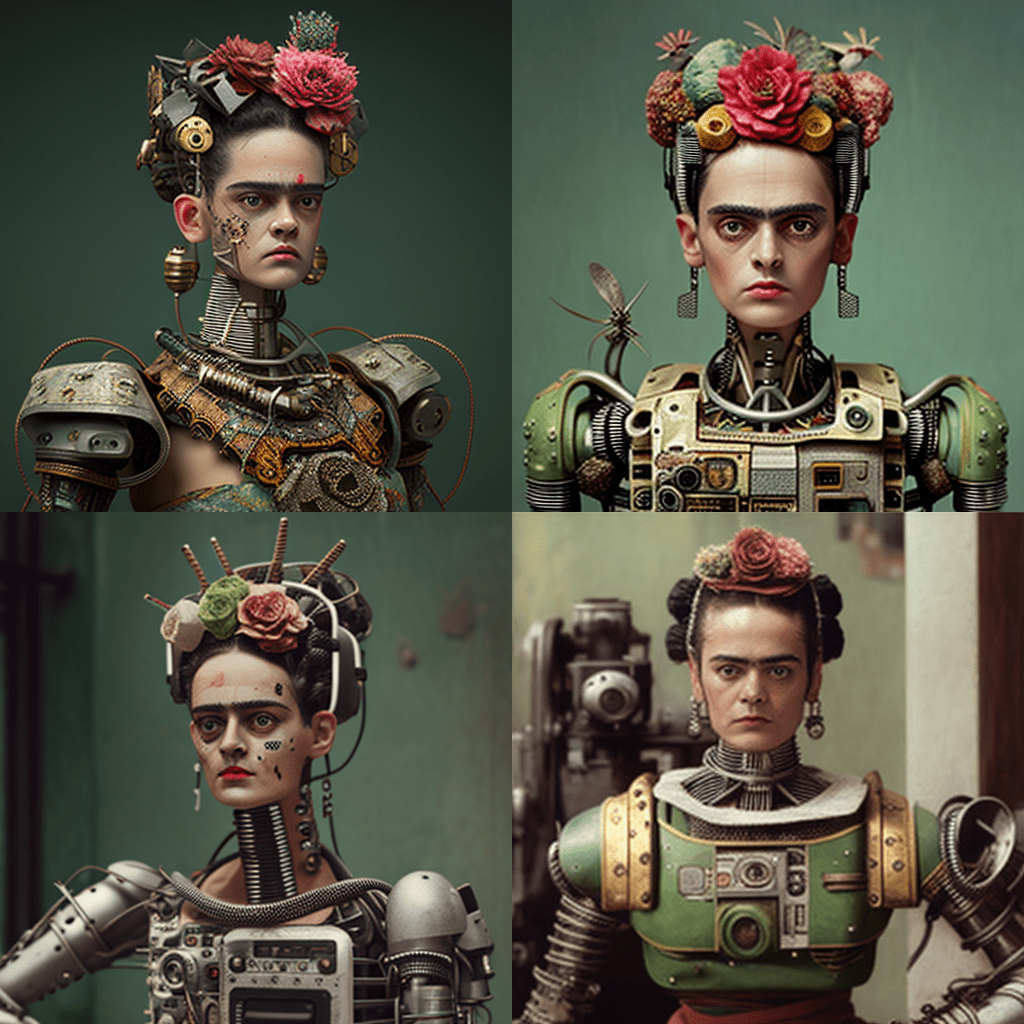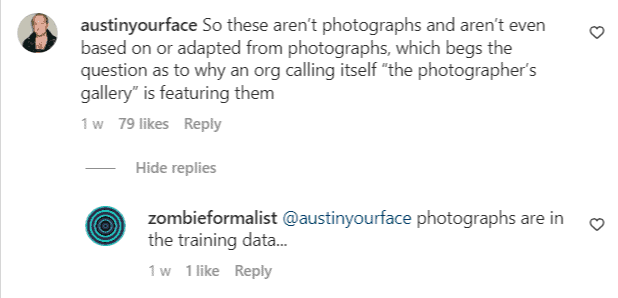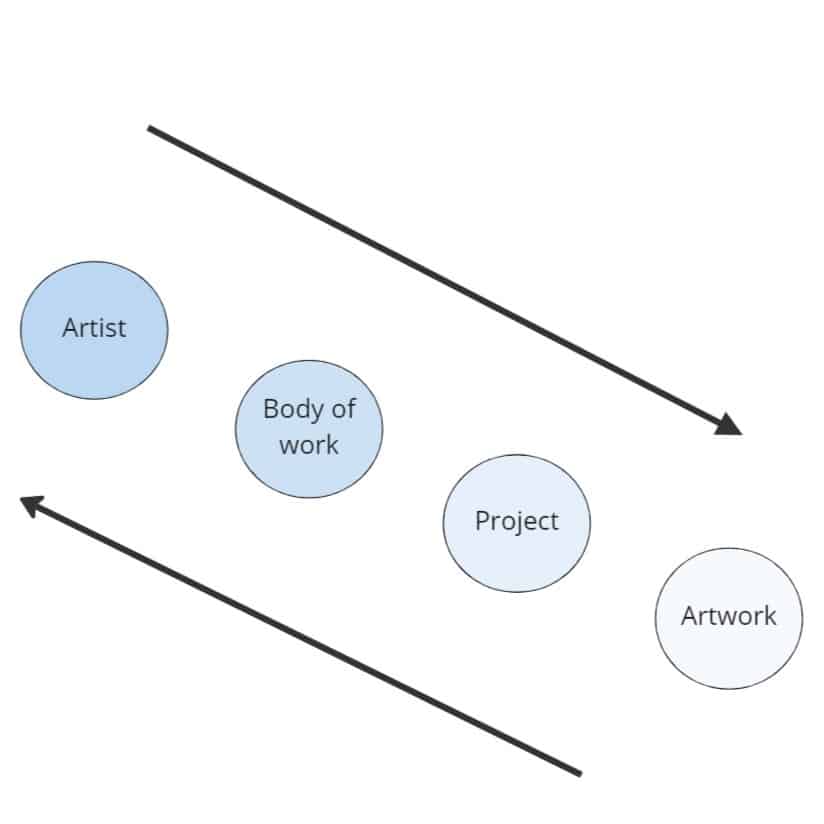
Generative AI, the technology behind a class of new artificial intelligence systems that can generate images, is in the news and is creating a significant amount of unease in the creative community.
We are going to cover this from the perspective of how this growing technology directly feeds into the way you should think about your career as an artist and the way you market your online art sales.
Ultimately, we have good news and good advice for creatives that are worried about their livelihoods being under threat. However we will start by talking through some recent controversies, and give you a little insight into the capabilities of this new technology.
Controversies & possibilities
In case you missed it this week there has been some controversy over at The Photographer’s Gallery. TPG regularly offers Instagram takeovers to photographers, and this week it was Mattia Dagani Rio’s turn to showcase his latest project, Los Santos, a work that “moves between the intertwines of masculinity, performativity and queerness, with an aura of intimacy and surrealism.
The controversy stems from the fact that all the images were produced using one or some of these new AI image generation tools, examples of which are Midjourney, Stable Diffusion and Dall-E. The images themselves were based on the illustration style of the Playstation smash hit game, Grand Theft Auto.
Understandably, many people commenting on the images felt that the creation process and resulting aesthetic took it outside of the remit of work that should be shown at TPG, and that the airtime should be given to photographers, who lack natural outlets for their work.
To be fair to TPG we would guess that they would feel self-expression needs to take precedence when offering Instagram takeovers. They have run some excellent programs recently around digital change and disruption in the photographic industry, so we think that if this recent situation has enabled that debate to be brought out into the open then it’s a good thing.
These images in particular were of an illustrative aesthetic. However AI does photorealism too.
For example, here’s a project by a prominent user of AI techniques, Tim Tadder. The project Spring Break is described as what happens when the Coachella generation gets old. As Tim puts it “Why does the party have to stop? I hope these images inspire you to not only never let the good times stop rolling but to push yourself to learn a new skill by pushing AI art to tell the stories of your imagination.”
AI’s inconvenient truth
The idea of having a photographic-style image without a camera involved is not new. Photorealistic CGI has been used in photography for years, mainly in the production of advertising assets, without generating much controversy. On the one hand people will say these tools expand what’s possible, and that all production techniques and technologies were controversial when first introduced.
One of the main sources of controversy over the use of AI systems in image generation is down to the way this technology has been developed. This comment on one of Dagani Rio’s images sums this up:

In case you are unfamiliar with how these generative AI models are created, they are trained on large datasets of images which then enables them to ‘re-imagine’ variations of these datasets based on text or visual instructions.
Artists are rightly concerned about this and would like to understand if their images have been used to train these AI models. None of the corporations involved in developing these systems have divulged which images were used in training their models, but they have previously stated that the methodology has involved scraping hundreds of millions of images with associated text captions from across the internet.
The inconvenient truth for these AI companies is that by doing this, they may have infringed intellectual property rights, although the law here is, as yet, untested. It is a widely accepted fact in the AI industry that high quality training data is vital to make an effective AI system. Undoubtedly human artists have influences too, but the industrialisation of creativity by ingesting millions of artists’ images is a different proposition.
(If you are concerned about whether your work has been used in a data training set for generative AI systems take a look at https://haveibeentrained.com/ and upload some of your images to find out. We are not affiliated or endorsing it in any way however it looks like the organisation behind it, Spawning.ai , is doing some great work in terms of pushing the debate forward on this. )
Art is more than making images
Looking beyond the concerning way intellectual property rights have been ignored in the development of these systems for a moment, their potential to create imagery is clear (otherwise this wouldn’t even be a debate). But what is their function?
To understand what makes a successful artist, regardless of whether you sell art online or offline through galleries, you have to understand why people buy art. There’s a clue in the way people talk about artists. They say things like, I bought a Banksy, I have a Nan Goldin print, I think Warhol is a genius etc.
Humans engage with humans. As Victoria Park (one of our highest sellers) says in the podcast we did with her: “people don’t buy the art, they buy into the artist”. Art buyers resonate with the artists’ journey, and buying a print is an expression of that.
Seeing artworks for the first time prompts questions like; who made it? why? what else have they made? We know we like it, but we want context. The artist is the story behind the artwork, giving the artwork context or meaning. Take the hugely successful Mr Doodle, for example. The interest in his work springs from the way day to day existence is committed to doodling his entire existence and surroundings, and his motivations and reasons for doing that. Without this part of the story, would the interest remain the same?
Here is a useful mental model for understanding all aspects of making art, not just the images themselves:

You can discover an artist in many different ways. You can discover an artwork first, or the artist themselves, or read about their entire body of work, or an individual project. If you engage, you want to know more. The point is that an artwork doesn’t exist on its own, without the other elements, and at the heart of that is the artist. On its own, with no context, an image is just an image.
The upshot for you, the artist, and your marketing
OK so once we can see where these AI generative tools fit in, and how they differ from what an artist does, this has clear implications for how you communicate as an artist in this fast changing creative industry.
If you just put your images out there, with no context, then you have neglected to communicate the fundamental difference between you and any other image maker (including AI). This is what we mean specifically when we say that, these are some of the things you could communicate:
- Your reason for doing what you do, your why (we recommend reading this book for more background)
- Your entire body of work
- Your creative process
- The genesis of the projects you do
- The projects, when they were done, how they led from one to the other, how you style and content developed over time
- You career highlights
- How you work is driven or interacts with your human and life experience
- How your philosophy, aesthetic, opinion feeds into your work
- Your influences
- Your surroundings and studio and how that inspires you
These are just some ideas that could be done explicitly or implicitly, through text, video or imagery, via social media, newsletters, your website, online talks. To learn more about this, read our recent article about creating your brand as an artist. We would also advise you to spend some time observing how other artists communicate, and to find a style that suits you.
To be clear this is not us recommending that you need to make Instagram Reels talking to the camera about your life or writing deep academic articles deconstructing your work (although it could be). It is about finding your style of communicating all that facets that make you an artist.
Spending some time on this (and getting some help if you need it) is vital. It’s what sets you apart, it’s what people buy into. People buy the artist, not the art. When you tell your story as an artist, your art sales will go up and you will not be disrupted by AI image generators.
Generative AI systems are creative tools, they are not artists. Indeed, if an artist decides to use AI image generators to create work that expands their own creative practice and it makes sense to their aesthetic, process and practice, then AI opens up new possibilities for artists and does not subsume or co-opt the artist (it’s the other way round). We are starting to see some interesting uses of AI by creatives in this way, here’s a few that caught our eye.
Geometrieva has been experimenting with a minimalist sci-fi noir design aesthetic:
Land of Arca has created an alternate reality with a sci-fi retro ’50s feel. They describe this as ‘Arca, a land where humans and AI have evolved as one’:
In the tradition of pop art but with an AI twist, Vjeko has been experimenting with blending iconic design with artistic or commercial aesthetics & forms:
AI image generators will disrupt the low end wall decor industry, where the pictures are sold on large marketplaces and the artist is just a name on a page with little or no context around them, the work or why they do what they do. In these generic superstores of posters, it is no surprise that price is the most important factor in getting sales. So, of course, if AI can create the pictures for pennies then in that race to the bottom there’s only going to be one winner (hint: it won’t be you as an authentic creative artist).
So, if you think that selling art is about competing on cost then we can assure you that you’re doing it wrong. This is why we say don’t do 20% off on your art prints. Driving demand by lowering prices is detrimental to your brand, but you can do 48 hour free shipping offers to say thank you to previous buyers or as a perk for newsletter subscribers, because that is not discounting your art.
Selling art is not passive income
The bottom line here is that if you simply just chuck all of your work onto a web store, set a price and expect it to sell out then you are going to be very disappointed. Please beware of anyone who tries to sell you a system for doing that.
Selling art online is a sustainable and viable long term career for a creative. In fact it is way more than viable. Done right, it is downright lucrative. However one thing selling art online is not is passive income. You will have to work at it, and spend a large proportion of your time on communication, to build an engaged audience. When you do the reward is that you get to do what you love, to express yourself and to make your ding on the universe.
Selling art is a human-to-human connection thing. So when you do it right, you do not have to worry about machines taking this away from you, because no one has the life journey, experience and outlook that you have.
You are unique. Celebrate that. And communicate it.
If you want to read more advice about how to market yourself properly as an artist, read our art sales advice help centre and listen to Season 1 of our podcast Sell Out. Also sign up to our mailing list to receive updates about the upcoming webinar episodes.
1 Digital Single Market (CDSM) Directive in 2019
2 https://openfuture.eu/blog/protecting-creatives-or-impeding-progress/